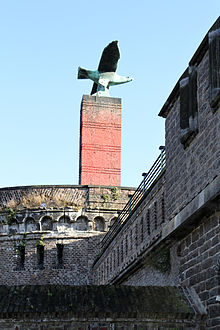Friedenspark (Cologne)
Friedenspark is the name of a city park in Cologne's Neustadt-Süd district that has existed since 1914 .
History of origin
On March 19, 1914, the city decided to create a park around Fort I based on a plan by Fritz Encke . It was the first park in Cologne on a fortress wall, the so-called "Rheinschanze". The park initially remained nameless when it was created in 1914 by Enke on the site of the old Fort I. Encke integrated the old fortress walls and ditches into his park concept, which means that the park's appearance today is characterized by overgrown masonry.
The 4.5 hectare park received a monument built by Otto Scheib in 1927 with an eagle sculpture by Georg Grasegger for the soldiers who fell in World War I (“The Heroes of 1914-1918”). Scheib named the monument Numero oppressis mente invictis (inferior to the multitude, undefeated in spirit). The 15 meter high monument with the war eagle made of cannons from the First World War was inaugurated on July 3, 1927 under the patronage of the later Reich President Paul von Hindenburg . A staircase leads to the monument, on which several bronze plaques are attached. At the same time the park was named Hindenburgpark. The pergola forms a spatial closure of the rose garden to the banks of the Rhine, the sunken garden (a lowered perennial garden with a fountain in the center) has bunks framed by hedges that invite you to read. In 1985 it was renamed Friedenspark.
use
After the University of Cologne moved into the neighboring Claudiusstrasse 1 on June 12, 1919, the university used the old Fort I with 600 m² of interior space as a cafeteria until it moved on October 1, 1934 . Between 1939 and 1945 it served as an anti-aircraft position, which was installed on the roof of the redoubt . In the post-war period, the branch of the Cologne tax office was housed here. The municipal garden department has been using part of the fort since 1971; today it is the Cologne Youth Center. V. housed. Right up to the memorial there is an extensive adventure playground, the "Friedenspark building playground" belonging to the youth center. A climbing paradise was created here right next to the south bridge, which, with around 30 climbing routes in degrees of difficulty 5–9, is a popular outdoor climbing option in the south of the old town.
location
The Friedenspark is located between Alteburger Straße and Oberländer Wall and borders the driveway to the south bridge in the south . It is accessible from Agrippina-Ufer, Oberländer Wall and Alteburger Straße and is part of Cologne's green belt . Further north, across Titusstrasse, is the Römerpark .
Trivia
- Heinrich Böll , born in the nearby Teutoburger Straße 26, played as a child in the former Hindenburgpark, "sitting on the curb, with his feet in the gutter, still too small to play hopping, but big enough to play ball". In the Friedenspark there are references to Böll's novel “ Billiards at half past nine ”.
- The war memorial inspired the Bläck Fööss to write the song Ungerm Adler (LP Zweierlei Fööss ; 1986). Here they remind you of what the eagle literally stands for - that there will never be war again.
literature
- Jutta Curtius: “You shouldn't forget it”. 100 years Peace Park Cologne. Fritz Encke (1861-1931) . In: Die Gartenkunst 26 (1/2014), pp. 73–88.
Web links
Individual evidence
- ↑ Peter Fuchs (Ed.), Chronicle of the History of the City of Cologne , Volume 2, 1991, p. 345
- ^ Gerhard Kolberg / Karin Schuller-Procopovici, Sculpture in Cologne: Image Works of the 20th Century in the Cityscape , 1988, p. 78
- ^ Heinrich Böll, Heimat und keine: Schriften und Reden, 1964-1968 , 1985, p. 117
Coordinates: 50 ° 55 ′ 2.6 ″ N , 6 ° 58 ′ 5.3 ″ E


